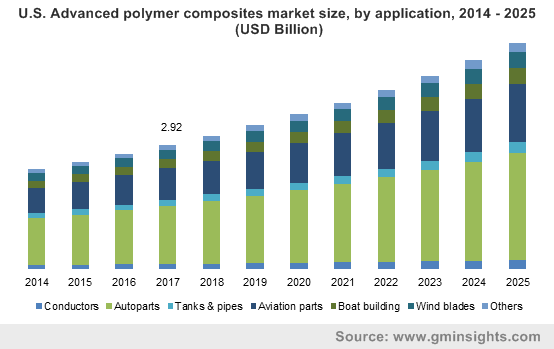Advanced polymer composites market valuation to surpass USD 17 billion by 2025, increasing demand for wind blades to substantially augment the industry outlook
Publisher : Fractovia | Latest Update: 2018-11-19 | Published Date : 2017-03-23Request Sample
Growing preference for stronger and lighter materials in the manufacturing sector has bolstered the global advanced polymer composites market earnings, that exceeded USD 9 billion in 2017 owing to the extensive application scope of these composites. Superior resistance to abrasion and fatigue have made these composites ideal for producing aircraft wings, nacelles, rudders, landing gears as well as various automobile parts and wind turbine blades. Evident significance of the advanced polymer composites market across several industry domains has ensured a steady growth in the research and development of specialized products and services. Over the last few years in particular, the production of wind blades to support the exponentially rising investment in renewable energy has been a notable factor influencing the advancement of the advanced polymer composites industry.
U.S. Advanced polymer composites market size, by application, 2014 - 2025 (USD Billion)

Wind turbines, considered to be the composite segment’s fastest growing application, are benefitted by the excellent stiffness to weight ratio and fatigue properties of composites, which also allow the development of bigger blades and optimization of the blade’s harnessing capacity. Experts believe composites like carbon fiber will be vital in delivering the required toughness and light weight for larger turbine blades, indicating huge growth prospects for the advanced polymer composites industry. By the end of 2015, the wind power generation capacity globally had reached 435 GW with expansive onshore and offshore projects completed at the time. The fast-paced development of the wind energy segment can be understood by the fact that China had installed almost 45% of all its new capacity in the year 2014 itself, when it reached a capacity of nearly 114.7 GW.
Governments all round the world have promoted the adoption of renewable energy and introduced major laws to help producers explore wind and solar energy, in addition to providing suitable financial aid. However, as government subsidies get reduced the wind power sector will depend on raising efficiency of turbines by increasing blade sizes, bringing the advanced polymer composites market into play. Throughout different regions, projects are being planned to tap into the tremendous wind potential near oceans and on land. Estimates show that about 1 million GW of wind energy can be harnessed from the overall land coverage on Earth and approx. 1% efficient use of this potential can meet the world’s electricity demand. Subsequently, prominent industry players are collaborating with regional companies and authorities to build giant wind farms, propelling the advanced polymer composites industry expansion.
Essentially, wind blades on offshore platforms have to bear extreme weather conditions and need to be built using the strongest composite materials which can endure high winds and other natural forces. Asia-Pacific countries like Australia, China, India and most of the small nations in the region have enormous offshore wind potential, which is gradually being developed. Speaking on the efforts to propagate renewable energy in smaller countries, Taiwan had recently announced that it would be selecting a total of 5.5 GW of offshore projects soon. The projects are scheduled to be completed by 2025 and represent the opportunities for the advanced polymer composites market from the offshore wind segment. Europe, too, boasts of massive offshore wind potential and developed nations like the U.K., Spain and Germany have been quick to adapt to renewable energy.
Elaborating further, Germany had added 222 wind turbines, having 1.25 GW capacities, in 2017 along the North Sea and the Baltic Sea, which accounted for 40% of the total capacity expansion worldwide in that year. It is projected that the offshore wind capacity in Germany could rise to 15 GW by 2030, demonstrating a lucrative revenue source for wind blade manufactures and the advanced polymer composites market in Europe. Contribution of the U.S. offshore wind industry in advancing the renewable energy segment is also incredible, as it is touted to have the second largest wind power capacity. The Empire Wind project, being planned in the waters around 15 miles from Long Island, will supposedly be spread across 79,000 acres of leased federal waters, consist of hundreds of wind turbines and would be completed by 2025.
All in all, rapid development of the wind power generation sector has presented a significant demand for bigger, stronger and lighter wind blades, that would eventually impact the revenue scale of the advanced polymer composites industry. With the global wind energy industry pegged to register a valuation of USD 111.4 billion in the next six years, remuneration for the advanced polymer composites market is anticipated to exceed USD 17 billion by 2025.